SPECIAL
FOCUS: NORTH AMERICAN OUTLOOK
Small E&P firms to determine direction
of US land market
While
large E&P companies involved in exploitation of unconventional
reserves
continue employing a large number of rigs, small firms, more prone
to seasonal
behavior, will direct overall trends for the year.
Richard Mason, Publisher, The Land Rig Newsletter
Is it the pause that refreshes, or a signal of a maturing land market?
With the first half of the year behind the industry, the US land market
is still a puzzle when discussion turns to how drilling activity will
play out in 2007. Depending on which rig count one follows, activity
is either slightly up (Baker Hughes, by 4.6%) or has decreased by as
much as 100 rigs at various times since October 2006.
Operators are on record for single digit percentage increases in 2007
capital expenditures for the onshore market, according to various industry
spending surveys. The question is whether increased field costs account
for the increased Capex, while drilling levels stay similar to 2006.
The land market has certainly witnessed its share of extenuating circumstances.
Persistent late winter weather in the first half of 2007 yielded to
a very wet second quarter, particularly in south-central US drilling
markets, hobbling rig moves and slowing drilling programs well into
summer.
A BIFURCATED MARKET
Numbers from Fort Worth-based RigData, a permit and rig activity tracking
service, show first quarter 2007 drilling volume dropped 6.3% sequentially
to 54 million ft in the major US onshore drilling markets, exceeding
the mild 1.4% decline in the fourth quarter 2004. On a nominal basis,
the first quarter decline amounted to 3.5 million ft versus the prior
quarter. For background, consider that the onshore market has more
than doubled its quarterly footage run rate from a trough of 22 million
ft in the first quarter 2002 to a peak of 58 million ft in the final
quarter of 2006, the most recent high. During that time, the onshore
market evolved into two segments as higher commodity prices and technology
advancements opened unconventional reserves to economic exploitation
(see World Oil, pg. 43, August 2006).
It helps to examine multiple data
points to see whether the market has softened or just paused to catch its
breath. Recent industry metrics confirm the onshore market has bifurcated,
with each segment exhibiting measurable, though dissimilar, characteristics.
Those metrics support the general consensus that the US onshore market
has undergone a transformation that emphasizes unconventional oil
and gas targets, typically defined as tight sands, shales and coalbed
methane. The bifurcation is reflected in industry data points such
as rig counts, footage and rig employment patterns among E&P
companies; the metrics associated with unconventional drilling grow,
while those tied to conventional activity fluctuate seasonally, or
respond to price-based market events.
The issue remains whether the unconventional
phase of evolution in the onshore market is flattening out after
non-stop growth over the last three years-just when the conventional
segment reaches the latter stages of maturity. First quarter 2007
experienced a decline in footage for only the second time in four
years, according to RigData tallies. The event had two manifestations:
while overall footage dropped, non-vertical footage increased. Non-vertical
footage is a reliable proxy for unconventional activity.
Migration to onshore. Growth in the unconventional
market is tied to the diffusion of technologies from the offshore
environment to onshore applications. It also illustrates a migration
of independent E&P
firms who exited the offshore shelf and moved onshore into unconventional
plays. The June 2007 announcement that Newfield Exploration is selling
its Gulf Coast shelf properties to concentrate on the Woodford Shale,
Monument Butte and other US land positions was the latest in a series
of transactions. These date to 2004 and involve offshore independents
gaining positions in unconventional plays through acquisitions, including
Noble Energy/ Patina Oil and Gas (2004), Kerr McGee/Westport (2004)
and Pioneer Natural Resources/Evergreen (2004). At the same time, several
land-based E&P firms amassed onshore properties in unconventional
plays through acquisitions, including EnCana/Tom Brown Inc. (2004),
ConocoPhillips/Burlington Resources (2005) and Anadarko Petroleum Corporation/Kerr
McGee/Western Gas Resources (2006).
These events represented a modern-day
land rush as large E&P firms
jockeyed for positions in unconventional shales or tight sands. Everyone
either had an unconventional play, or was looking to get into one.
The trend culminated in 2006, which was the year of the shales. Production
grew significantly from the Fayetteville and Woodford shales (both
closing in on 100 MMcfd) as well as continued extension of the Barnett
Shale play. That land rush is largely finished, and the industry is
actively monetizing the reserves, which may be a sign that the onshore
unconventional play is transitioning from an expanding discovery phase
to a more mature, stable exploitation phase.
SEASONALITY IN RIG USE
The publicly held national drillers reported as many as 160 rigs stacking
out for lack of work during first quarter 2007 earnings reports. Footage
dropped sequentially, and The Land Rig Newsletter surveys found day
rates initially declining between 10 and 15% after the first of the
year, indicating the supply of drilling rigs exceeded demand for drilling
services. At mid-year 2007, day rates had firmed for intermediate rig
classes in many geographic markets at levels that were 15 to 20% below
2006 peaks. They were still falling in modest increments of a few hundred
dollars a day for smaller class rigs, particularly in the Midcontinent
and Permian basin.
Why the decline? Yet the question persists:
Has the market grown soft, or was it simply snakebit by a combination
of external events like weather? Rig employment patterns provide
some markers to watch in the third quarter. For example, the conventional
market is characterized by greater seasonality in rig count than
the unconventional market. This is evident when measuring the number
of companies employing land rigs. That total fluctuates up and down
by as much as 70 companies annually, hovering around an average of
525 operators. Figure 1 illustrates the cycle on a quarterly basis.
The trend line shows fewer operators employing rigs during the first
half the year and more operators employing rigs in the second half.
These oscillations relate to seasonality for smaller E&P firms,
tied more often to conventional oil and gas targets, who are assembling
prospects, financing and resources early in the year and moving into
the field in the second half of the year. These companies seldom
appear in the various industry spending surveys, yet their behavior
has significant influence on rig employment in the second half of
the year. The number of operators employing land rigs dropped to
the lowest levels in three years during the first half of 2007; the
unanswered question is whether this segment of rig employment will
re-enact seasonal patterns or remain on the sidelines in 2007.
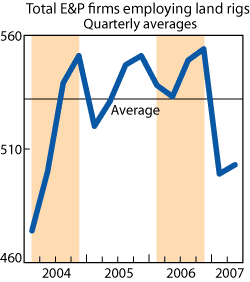 |
Fig.
1. Seasonal rig employment patterns. |
|
Changing structure in onshore
rig demand. The market exhibits greater concentration in rig employment among
fewer firms whose main emphasis is on exploitation of unconventional
oil or gas reserves. Figure 2 contrasts rig employment for the largest
and smallest drilling programs. In early 2004, both segments accounted
for roughly 40% of rig employment. However large independents have
increased rig counts aggressively over the last three years, with
most of these involved in unconventional natural gas programs. Currently
the most aggressive drilling programs, which consist of about three
dozen E&P firms employing 10 or more
rigs, account for 55% of rig employment, while the smallest drilling
programs, which consist of roughly 425 E&P firms employing three
rigs or less, have seen share decline to about one third of the market.
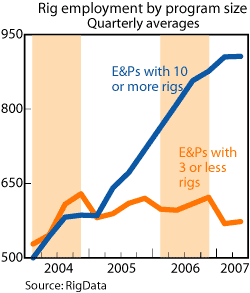 |
Fig.
2. The growing contrast of rig activity by
program size. |
|
The Land Rig Newsletter studies indicate
the Top 5 E&P rig employment
programs have grown from 14% of active rigs in the second quarter 2005
to 20% of active rigs in the second quarter 2007. Even at peak rig
counts in October 2006, the Top 5 rig employment programs reflected
18% of active rigs. The cast changes by quarter, but the largest domestic
land drilling programs include Chesapeake Energy Corporation, XTO Energy,
Inc., ConocoPhillips Company, Devon Energy Corporation, EOG Resources,
Inc., EnCana Corporation and Anadarko Petroleum Corporation, who employ
anywhere from 45 to 140 rigs each. A change in rig employment behavior
among a half dozen E&P firms can have significant impact on rig
demand nationally. The thesis is that growth through the larger E&P
firms is blocking prospects in unconventional plays and relegating
smaller E&P firms to a shrinking pool of highly mature conventional
prospects. The smaller E&Ps find these prospects marginally economic
and subject to fluctuations in commodity prices and service cost pressures.
Figure 2 also shows that rig use by large
E&P firms flattened
in the first half of 2007 following notable expansion after 2004, raising
the question of whether the most aggressive firms have peaked in rig
employment following the 2004-06 land grab. The graph also shows seasonality
among the smaller E&P drilling programs. If large E&P companies
have peaked, rig count direction for the remainder of 2007 rests solely
on the seasonal behavior of small and privately held E&P firms.
UNCONVENTIONAL DRILLING UNPHASED BY DECLINE
Unconventional efforts often employ non-vertical
drilling to apply precision-placed multi-stage fracture stimulations
downhole to open low porosity reserves that were previously uneconomic.
Non-vertical drilling therefore serves as a proxy for tracking unconventional
efforts. Evidence of market bifurcation is present in Figure 3, which
illustrates trend lines for quarterly footage in vertical and non-vertical
configurations. Vertical footage declined 10% during the first quarter
2007, falling to fourth quarter 2005 levels. The decline is tied
to conventional drilling with small E&P firms seasonally stepping
back from the rig market. In contrast, non-vertical footage volume,
a proxy for unconventional oil and gas targets, rose from 26% of
the footage market in the fourth quarter 2006 to 29% in the first
quarter 2007.
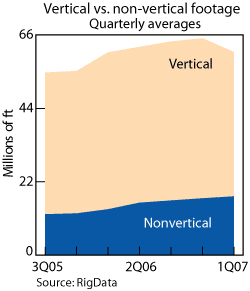 |
Fig.
3. Footage drilled in vertical and non-vertical
wells. |
|
The unconventional market has two major bookends. The first is the
shale plays in the south-central United States including the Barnett,
Fayetteville, and Woodford shales; the second is tight sands and shales
in Wyoming and Colorado. Horizontal drilling is more common in the
south-central US, while directional drilling more frequently manifests
in Colorado and Wyoming. Horizontal footage rose 40% year over year,
including 7% sequentially during the first quarter 2007. Much of the
gain derives from expansion in drilling activity in the Fayetteville
(Arkansas) and Woodford Shales (Oklahoma), coupled with continued expansion
in the Barnett Shale play in North Texas. The Barnett Shale accounted
for 54% of horizontal footage in the first quarter 2007 and is equivalent
in volume to the combined directional footage in Colorado and Wyoming,
Fig. 4. Similarly, directional footage grew 14% sequentially in Colorado
in the first quarter 2007 and was up 47% year over year.
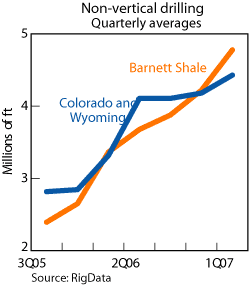 |
Fig.
4. Non-vertical footage drilled in the Barnett
Shale vs. Colorado and Wyoming. |
|
RIG CAPACITY EXPANDS; PRICING IS SOFT
Two major 2007 questions for operators
involve rig capacity and rig pricing. RigData recorded more than
140 rigs entering the market in the first five months of 2007, led
primarily by newbuild programs at Helmerich & Payne I.D.C. and
Nabors Industries. RigData estimates more than 275 units are headed
to the fleet in 2007, based on contractor surveys. That has created
concern that rig supply will vastly exceed demand for drilling services
in 2007. However, attrition plays a role in net capacity additions.
According to the Reed Tool Census, attrition historically ranges
between 4 and 8% of the rig fleet. With attrition similar to historical
levels, net growth in the US land fleet should be half to two-thirds
of rig additions in 2007. For example, while the land fleet witnessed
the addition of 140 new units during the first five months of 2007,
the marketed fleet actually declined by 35 units during the same
period, indicating that refurbished or newbuild units are replacing
legacy conventional rigs.
Figure 5 shows capacity additions clearly overshot demand for drilling
services in late 2006. Percentage utilization of the US land fleet
declined steadily from 84% in January 2006 to 80% when rig count peaked
in October 2006. Afterwards utilization fell rapidly to 74% in March
2007. Utilization improved to 77% at the end of the second quarter
2007, but had not yet reached the 80% level at which rig pricing tends
to strengthen.
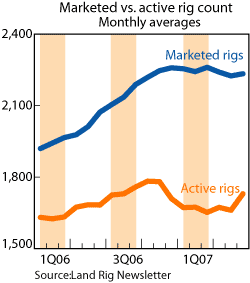 |
Fig.
5. Marketed rig counts compared to active
rig counts. . |
|
A majority of leading indicators suggest
activity will improve in the second half of 2007 and should be enough
to absorb additional rig capacity. Rig pricing should firm, though
it is unlikely to repeat the peak levels seen in the second half
of 2006. That has been the forecast story line all year, yet those
expectations had not yet shown in field activity. The answer to whether
the land market has entered a more mature phase, or is simply pausing
to catch its breath depends on the rig employment patterns of small
and privately held E&P
firms in 2007, the “dark matter” of the US land drilling
universe. 
|
THE AUTHORS |
|
Richard
Mason, is publisher of The Land Rig Newsletter,
a monthly publication that provides trends analysis for the
land-based contract drilling sector of the oil and gas industry.
He previously worked 10 years as a field historian for the
Texas Tech University archives, collecting historical materials
on petroleum, agriculture and irrigation development in the
American Southwest. Mr. Mason is a 1974 graduate of Ohio
University with a bachelor of arts degree, with honors, in
history. |
|








